Russian Red Lines and Risk Calculus?
By Dr. Graeme P. Herd, Dr. Pál Dunay and Dr. Cüneyt Gürer, Marshall Center professors
Photos By THE ASSOCIATED PRESS
Prologue:
The past is never dead. It is not even past.
On September 27, 2020, violence resumed between Armenia and Azerbaijan over Nagorno-Karabakh, the Armenian-majority-populated enclave located within the internationally recognized borders of Azerbaijan, and seven surrounding districts that had been under the control of Armenia since the end of the first Nagorno-Karabakh conflict (1988-1994). Forty-four days later, on November 9, 2020, a cease-fire, imposed by Russia, was signed by Azerbaijan, Armenia and Russia, thereby reversing Armenia’s gains from the first conflict. Small, landlocked and resource-poor Armenia could not compel Azerbaijan, a country with three times the population and territory, to recognize its decisive victory from 1994 or prevent the Azeris from rearming and preparing for war.
The analytical community offered little consensus about what to conclude concerning the relationship between the outcome of the conflict and the risk calculus that informed Russian decision-makers. Dmitri Trenin, director of the Carnegie Moscow think tank, suggested the conflict highlights a new Russian modus operandi based on calculating risk to achieve pragmatic and vital Russian interests. Such an approach is free of emotional or ideological attachments, adheres to formal obligations, but no more, and seeks to manage third powers in the former Soviet space to minimize threats to core Russian interests. Others disagree. Mark Galeotti, a writer and lecturer on Russian security affairs, advances what could be termed a “managed decline” thesis, noting that Russia was forced to escalate its commitment through a new peacekeeping operation (PKO) and Federal Security Service deployment to Nagorno-Karabakh and the Meghri corridor (Armenian territory that links Azerbaijan to its western Nakhchivan enclave) respectively. He views this in terms of Russia “laboring to hold back decline.” Russian defense analyst Ruslan Pukhov was more direct and emphatic: “The geopolitical consequences are disastrous not only for Armenia, but also for Russia. Russia’s client and ally was the loser. The Turkish ally won convincingly. Behind the thin veil of a deceptive foreign policy triumph, namely successful mediation and bringing peacekeepers to the region, the harsh reality is that Moscow’s influence in the trans-Caucasus region has sharply decreased, while the prestige of a successful and a pugnacious Turkey, on the contrary, has grown incredibly.”
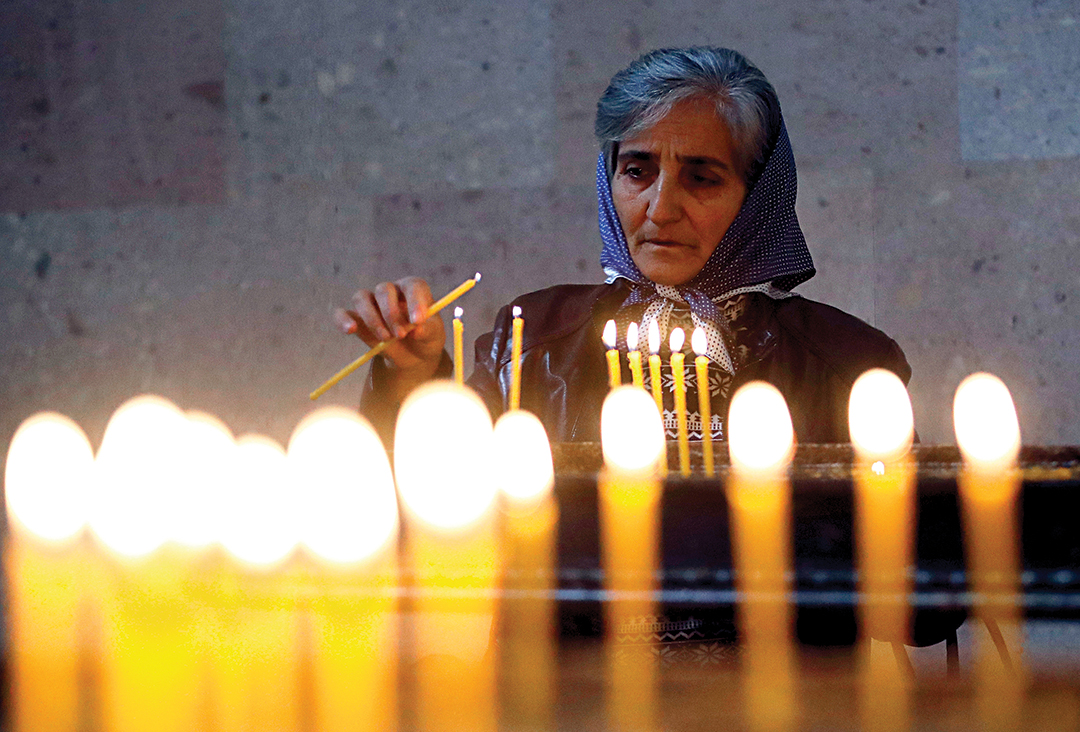
The term “red lines” originates from the 1928 “Red Line Agreement” involving oil companies from the United States, France and the United Kingdom, when an Armenian businessman used a red pencil to somewhat arbitrarily draw up new borders, dividing the defeated Ottoman Empire. Here, red lines signal core or vital interests as defined by the Kremlin. The declaration of a red line to an adversary is designed to manipulate and change its behavior. For red lines to be credible, retributive consequences should fall on the adversary when they are crossed; if not, reputational and credibility costs are incurred by the declarative actor. We can posit that when Russian President Vladimir Putin and his senior strategic advisers meet to discuss the use of force, the following understandings and rationales are at play when calculating associated risks, costs and benefits. First, they are likely to discount an event or action that they deem too risky. Second, they will base their decisions on assessments that potential benefits justify the taking of risks. Third, they will take into account the actions of third parties and consider whether they are too risky to ignore and thereby cross a threshold for Russian action.
Act I: Failed diplomacy
When the Soviet Union dissolved, successor states agreed that the former administrative borders of the once constituent republics would become state borders in accordance with uti possidetis, a term defined by Merriam-Webster’s Dictionary of Law as “a principle in international law that recognizes a peace treaty between parties as vesting each with the territory and property under its control unless otherwise stipulated.” Between 1988 and 1994, Armenia and Azerbaijan fought a war that the Armenians won. It occupied Nagorno-Karabakh (or as it is called in Armenian, the Republic of Artsakh) and seven districts around it, constituting 13.6% of Azerbaijan’s territory and resulting in 600,000 to 800,000 internally displaced Azeris.
This became a “frozen conflict,” characterized by ineffective conflict resolution efforts and periodic volatility, including a four-day skirmish in April 2016 (200 casualties), and violence in June and July 2020, with only very slight changes to the status quo on the ground. The Organization for Security and Co-operation in Europe (OSCE), through the Minsk Group co-chaired by Russia, France and the U.S., engaged in conflict resolution efforts. These proved unsuccessful due to several complicating factors. Russia always perceived its role as the ultimate and decisive matchmaker, able to operate outside of multilateral conflict management structures. When new fighting erupted in September 2020, the U.S. faced two difficulties. First, the Trump administration’s reservations about the efficacy of multilateralism extended to the OSCE. Second, the war coincided with the most intensive phase of the 2020 presidential election campaign and this directed attention away from international matters. After France declared the 1915-16 actions of Turkey (then called the Ottoman Empire) against Armenians a genocide, France was seldom regarded as an evenhanded, neutral party by Turkey and Azerbaijan.
The protracted conflict became hostage to respective national narratives, undercutting bilateral resolution efforts. Designs on securing and even extending Armenia’s battlefield victory in Nagorno-Karabakh highlighted dangerous overconfidence, even hubris, in Yerevan. Armenia consistently declared its readiness to settle the dispute peacefully, but in practice proved unwilling to accept any compromise that would have required giving up territory. Despite a meeting between Armenian Prime Minister Nikol Pashinyan and Azerbaijani President Ilham Aliyev in February 2019, in which the two agreed on the need to prepare their respective peoples for peace, relations soon soured. In March 2019, then-Armenian Defense Minister David Tonoyan shifted the notion of “land for peace,” an original justification for the seizure of the seven districts that surround Nagorno-Karabakh, to “war for new territories” — should Baku initiate a new war, Armenia would acquire even more Azeri territory by force. Such maximalist rhetoric was matched by Pashinyan in August 2019, when even the pretense of negotiation was taken off the table: “Artsakh is Armenia, and that’s it!” he declared. Because restoring control over Nagorno-Karabakh was also central to the Azeri state-building project, Pashinyan’s statement was understood in Baku to indicate that the diplomatic path to conflict resolution represented a strategic cul-de-sac. This conclusion was supported by failed diplomatic efforts by the U.S. at Key West in 2001, and by then-Russian President Dmitry Medvedev’s Kazan initiative of 2011.
Prophetically, in the mid-1990s Yevgeny Primakov, head of the Russian external intelligence service at the time, warned then-Armenian President Levon Ter-Petrosyan that “Azerbaijan can work and wait. They have the resources. In 10, 20, 30 years they will gain strength and take everything from you.” However, not even Primakov could take into account that Azerbaijan, despite massive military investment (a tenfold increase in military spending between 2006 and 2016) and with a six-times-greater gross domestic product than Armenia’s, would still need decisive Turkish military support to largely restore the prewar borders.
Act II: Nagorno-Karabakh, Armenia, Azerbaijan, Russia and Turkey
Militaries usually prepare to fight the last war, but not in every case. The second Nagorno-Karabakh conflict was expected to end in deadlock and exhaustion. As both sides appeared evenly balanced, a war of attrition would rage until overtaken by winter. However, this was not the case. There were differences in objectives — Armenia sought to hold territory that it had controlled for more than 25 years; Azerbaijan had to prepare to seize (regain) territory — and differences in military preparedness. Armenia’s reliance on heavy armor was hampered by poor and inaccurate targeting of Azerbaijani hydrocarbon production and transport infrastructure and by weaker logistical support, which affected the medical evacuation of the wounded.
Azerbaijan increased the mobility of its forces, diversifying weapons acquisition to two other major suppliers besides Russia — Turkey and Israel. The Turkish Bayraktar TB2 attack drones, tested in warlike conditions in Syria and Libya, outmatched an Armenian air defense system configured for fast, low-flying manned aircraft. Their deployment was complemented by shared Turkish intelligence, military advisers, logistical help and proxy forces, including Turkish drone pilots operating out of Erzurum. This support accounted for the targeting of Armenian battle tanks and ranking military commanders; one strike wounded the defense minister of Nagorno-Karabakh. The contribution and scope of Turkey’s military commitment in support of Azerbaijan throughout the conflict was clearly agreed in advance using previously established institutional cooperation mechanisms. Turkish-Azerbaijani relations are based on long-standing cultural and linguistic ties and shared identity, buttressed by pan-Turkic sentiment. Motivation for Turkish military support can also be explained by President Recep Tayyip Erdoğan’s more assertive regional policies, changes that followed the 2011 Syrian crisis.
Armenia was forced to accept a military defeat to avoid political-strategic annihilation. The Nagorno-Karabakh capital, Stepanakert, and the Lachin corridor, which connects Nagorno-Karabakh to Armenia proper, remained under Artsakh control, and a full humanitarian disaster was avoided. Pashinyan noted that Stepanakert (Xankandi in Azeri) was under direct threat, and if the cease-fire document had not been signed, “there was a high probability that Stepanakert, Martuni (Khojavend), Askeran (Xocali) would have been captured, after which thousands of our soldiers would have been under siege and a total collapse could have happened as a result.” Had this occurred: “20,000 Armenian troops and officers could find themselves surrounded by enemy troops, facing the prospect of being killed or captured,” he said. After Azerbaijan captured the key city of Shusha, 6.4 kilometers from Stepanakert as the crow flies and 14 kilometers downhill by road, the Ministry of Defense of Armenia and the chief of the general staff endorsed this assessment and supported the agreement, confirming that they would obey and execute it. In doing so, Armenian red lines were breached.
First, having previously posited “Artsakh” as an existential “civilizational front line” against “international terrorism,” Armenia is no longer the guarantor of Nagorno-Karabakh security. This military defeat represents a core identity loss for Armenia: Armenia failed to counter Azerbaijan in the field, and its efforts to coerce Russia into supporting it by targeting Azeri critical national infrastructure outside the conflict zone caused an Azeri attack on Armenia proper. Following the signing of the cease-fire agreement, demonstrations in Yerevan and elsewhere highlighted the loss of leadership legitimacy. Pashinyan was blamed for losing the war and accepting an agreement that is to the detriment of the country’s interests.
For Azerbaijan, the cease-fire signified a “glorious victory,” territorial restoration with the capture of Shusha as the symbolic prize (“Shusha is ours! Karabakh is ours!”), and regime legitimation, with its official narratives touting the necessity of a strong authoritarian leader. Aliyev publicly proclaimed: “The Patriotic War is over. Azerbaijan has won a brilliant victory in this war, our lands have been liberated from occupation, we have expelled the occupiers from our lands.” A month after the cease-fire agreement, a victory day parade was held in Baku, attended by Turkey’s Erdoğan. Aliyev achieved victory while maintaining relations with Russia and strengthening ties with Turkey. At the same time, the timing of the cease-fire between the capture of Shusha and imminent capitulation of Stepanakert allowed Aliyev to avoid ownership of a humanitarian disaster and subsequent ethnic cleansing and to avoid fighting in winter. Aliyev can now focus on returning Azeri refugees and internally displaced people to the now-Azeri-held portions of Nagorno-Karabakh and its seven adjacent districts. The process of “Azerbaijanization” of these districts is ongoing. Aliyev has also demonstrated that it is not just Russia that has military power capable of redrawing de facto borders in the post-Soviet space. In addition, the cease-fire opens the possibility of joint control of a new Azeri transit corridor — the Meghri corridor to Nakhchivan and then to Ankara.
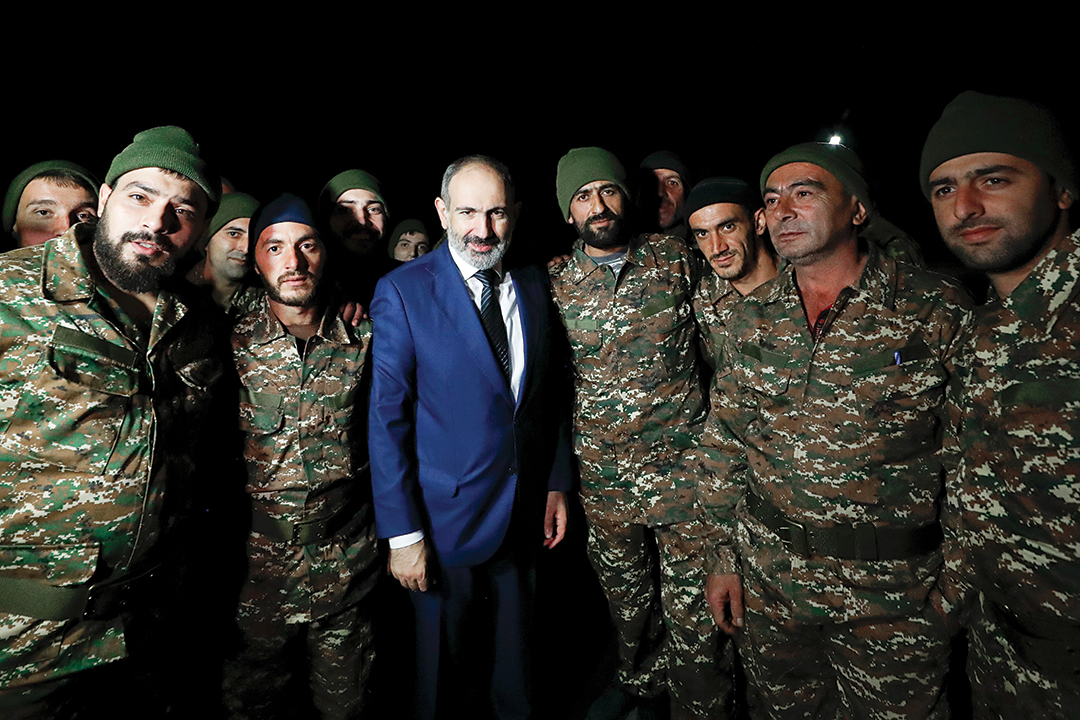
Assertive regional policies and nationalist discourse helped secure unanimous domestic Turkish political support for Azerbaijan during the conflict, leading to the military-patriotic legitimation of the ruling coalition, which consisted of the Justice and Development Party (Adalet ve Kalkinma Partisi or AKP) and the Nationalist Movement Party (Milliyetci Hareket Partisi or MHP). As a result of Turkey’s decisive contribution to Azerbaijan’s military victory, the power of Turkey and its president increased. This led to claims of Turkey’s future leadership in both the Islamic and the Turkic worlds, which many analysts consider too ambitious a projection. Turkey has inserted itself into the South Caucasus as a de facto power broker and a challenger to Russian hegemony and Moscow’s notion of a “sphere of privileged interest.” Turkey has solidified ties with Azerbaijan (with Aliyev referring to “my dear brother Recep Tayyip Erdoğan”) and Azeri energy corridors are strengthened, lessening Turkish dependency on Russia. The pro-government Milliyet and Türkiye newspapers both highlighted that Turkey and Azerbaijan will now be connected through the newly established Meghri corridor, highlighting pan-Turkic notions of solidifying historical ties across Turkic nations through connective land corridors to Baku and beyond. The flagship pro-government Sabah newspaper’s front-page headline read: “Two states, one victory,” referencing a popular phrase connecting Turkey and Azerbaijan: “Two states, one nation.” Another pro-government newspaper, Yeni Şafak, had the headline: “Iron fist, absolute victory.” Former Army Chief of General Staff İlker Başbuğ stated that his cherished hope is to see Turkey and Azerbaijan as one state, though he recognized this dream is not achievable.
During the conflict, Turkey demonstrated an ability to project power at low cost. It appeared to effectively deter Russia from wholescale support for Armenia by stating that this would trigger open Turkish conventional deployments on the side of Azerbaijan. With the cease-fire, Turkish Foreign Minister Mevlüt Çavuşoğlu, Defense Minister Hulusi Akar, Land Forces Commander Ümit Dündar and National Intelligence Organisation (MIT) chief Hakan Fidan met Aliyev in Baku, and it was likely that Turkish Special Forces and MIT, which typically deploy to grey zones, were on the ground monitoring the Russian PKO and new line of control. Although even the perception of empowerment is a double-edged sword, increased Russian-Turkish tensions are mitigated by open channels of communication and a history of managing brinkmanship in Syria and Libya through pragmatic and practical transactional horse trading.
As part of its previous regional policy, Turkey’s AKP government had initiated a normalization of relations with Armenia after signing the Zurich Protocols in 2009. Turkish President Abdullah Gül visited Armenia, and the two parties began to discuss opening their mutual borders as a goodwill gesture. This outreach was perceived negatively in Baku, with Aliyev accusing Turkish officials of “betrayal.” Erdoğan, then prime minister, was quick to reassure Aliyev that, despite rapprochement, borders would remain sealed until the Nagorno-Karabakh issue was resolved. A small number of contemporary Turkish experts argue that a balanced regional approach better aligns with Turkey’s national interests and suggest that the normalization process with Armenia be rekindled. At present, this option is not a political priority.
Russia was in frequent communication with Armenia from the onset of the war. This included exchanges between Putin and Pashinyan four times during the first 10 days of the conflict while, according to Russian media, Putin and Aliyev did not speak until October 7, more than a week after the start of the conflict. However, because Moscow had never recognized Armenia’s territorial gains as legal and did not allow multilateral and bilateral arrangements to extend to territories that Yerevan de facto controlled but that did not belong to its state territory, Moscow managed to avoid the imposition of a “2 + 2” formula (Armenia and Russia opposing Azerbaijan and Turkey). Russia was not therefore subject to the economic costs that would have resulted from breaking relations with Turkey and Azerbaijan. Moscow ended the conflict as de facto guarantor of security for both states and retains its position as a major regional powerbroker. It has increased its direct military presence on the ground with a new base in the South Caucasus, on Azerbaijan’s territory for the first time, though with increased accountability for the future of the enclave. Russia can use the PKO as a mechanism for direct mediation between Baku and Yerevan, replacing indirect influence exercised through the medium of arms sales. The Minsk Group is marginalized and with it, France and the U.S., upholding another Russian red line, that is, for external parties not to cross into and deploy forces into former Soviet geopolitical space.
Russia also appears to have constrained Armenia from escalating the conflict by launching missile attacks on Baku or directly targeting the Caspian-to-Mediterranean oil pipeline, thus avoiding deeper conflict with Turkey. At the same time, Russia signaled to Azerbaijan that an attack on Armenia proper — a march on Yerevan — would result in Russia adhering to its Collective Security Treaty Organization (CSTO) obligations. It used the loss of Russian life, after the Azeri military downed a Russian armed forces-operated Mi-24 helicopter that was flying in Armenia, to help bring Aliyev to the negotiating table and to sign the cease-fire. Russia’s leadership went further
when Sergei Naryshkin, the head of Russia’s foreign intelligence service (SVR), declared that Turkish-backed jihadi terrorist proxies should not be deployed to Azerbaijan. Russia signaled strategic intent by launching attacks on a Turkey-backed Feylak-i Sham (Sham Legion) training camp in Idlib, Syria.
A weaker and more dependent Pashinyan — or possibly post-Pashinyan — client state is also considered a positive for Russia. Armenia failed to uphold its own red line as guarantor of the security of Artsakh. This failure helps delegitimize the “velvet revolution” of 2018, which crossed Russia’s own red line against color revolutions on post-Soviet territory, and reinforces dependency links, even at the cost of resentment. When the war ended and demonstrations broke out in Armenia, official Moscow stayed silent but television news programs and talk shows started to be openly critical of the Armenian prime minister. Dmitry Kiselyev, the influential anchor of the weekly news program, “Vremya Nedeli,” went so far as to indicate that the leader of Azerbaijan is a more reliable partner than that of Armenia.
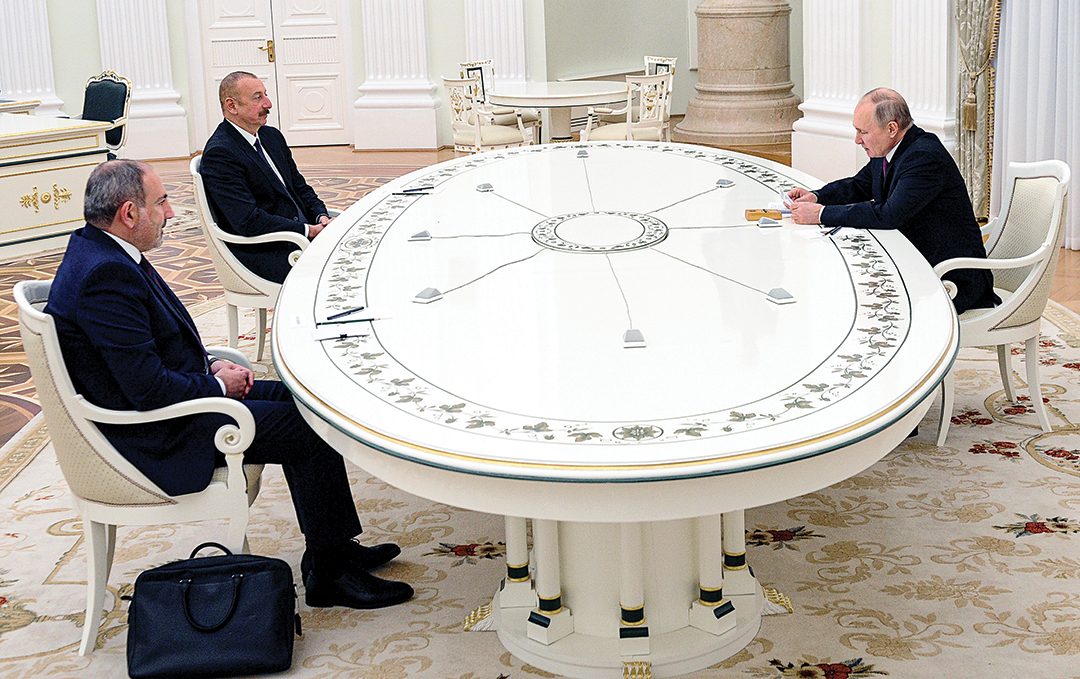
The costs to Russia of Armenia’s defeat appear manageable, even though nationalism, radicalism and anti-Russian sentiment in Armenia has increased and Armenian trust in Russian bilateral and multilateral mutual defense commitments has declined. The reality of the CSTO as an image-building structure, with little utility beyond that, has been underscored. Overall, however, conflict settlement has not meant an automatic loss of Russian influence. In fact, it could be argued that the cease-fire has expanded Russian influence in the region.
Act III: Cease-fire agreement
The cease-fire agreement brokered by Putin was signed November 9, 2020, by Russia, Armenia and Azerbaijan and came into force November 10. The declaration goes beyond a classic cease-fire agreement because it includes the return to Azerbaijan of territories still under Armenian control at the time and the deployment of Russian peacekeepers. The Russian peacekeeping force consists of 1,960 military personnel, 90 armored personnel carriers and 380 other vehicles along the line of contact in Nagorno-Karabakh as well as along the Lachin corridor. The PKO’s command headquarters is in Stepanakert. The agreement is for five years, with automatic renewal for regular five-year periods if none of the parties objects.
The text also contains several unresolved issues and ambiguities that have the potential to trigger new crises. Constructive ambiguity had a positive utility in the short term because it allowed the parties to reach a joint declaration and so avoid the very real immediate prospect of a humanitarian catastrophe in Stepanakert and ethnic cleansing. However, such ambiguity creates tensions and room for miscalculation in the longer term (“Kosovo syndrome”), especially since the future status of Nagorno-Karabakh was not addressed by the text.
One clear ambiguity concerns whether, as Aliyev stated, Turkey would participate in a joint peacekeeping mission with Russia within a new format. Erdoğan noted that he had signed a separate deal with Russia to take part in “joint peace forces” and that the Turkish-Russian control center would be set up in the “liberated part of Azerbaijan” to observe (through use of unmanned aerial vehicles and visually) compliance with the cease-fire and record, collect, summarize and verify information about cease-fire implementation. After the respective defense ministers, Sergei Shoigu for Russia and Akar for Turkey, signed the memorandum of understanding, Akar stated: “We say [Turkey] is both at the table and on the field.” This formula was repeated by the Turkish foreign minister and presidential spokesperson. On November 12, Çavuşoğlu stated that Turkey would have the “same role as Russia” at the monitoring center: “Whatever Russia’s role is, our role will be the same. If there will be violation, the center will determine this. We will even determine which measures will be taken together against this violation.” The joint center will be set up on Azerbaijani soil in a place to be determined by Baku. Russian officials in Moscow and Russian Ambassador to the European Union Vladimir Chizhov argued the opposite — Turkey would have no role to play in the former combat zone or in the coordination center, noting that the cease-fire declaration does not mention Turkey “even once.”
The ultimate status of Nagorno-Karabakh was not discussed in the agreement. As with the word “Turkey,” the word “Nagorno-Karabakh” is not mentioned in the text. This implies that the resolution of its status will be determined through Moscow-mediated negotiations between Baku and Yerevan. The agreement stated that Armenia had to hand over control of the seven regions adjacent to Nagorno-Karabakh in three stages, on November 15 and 20 and December 1, 2020, and the parties demonstrated some flexibility in the face of delays by extending the time period for return. Internally displaced people and refugees can return to Karabakh and the adjacent regions under the control of the United Nations Office of the High Commissioner for Refugees. Those who left Nagorno-Karabakh and the surrounding areas when the war broke out in late September 2020 and those who fled in the 1990s are free to return. Since neither the Azerbaijanis nor the Armenians want to live in territories controlled by the other, in effect spontaneous ethnic self-cleansing or displacement has occurred, mitigating the use of coercion to force relocation and minimizing local acts of intercommunal violence.
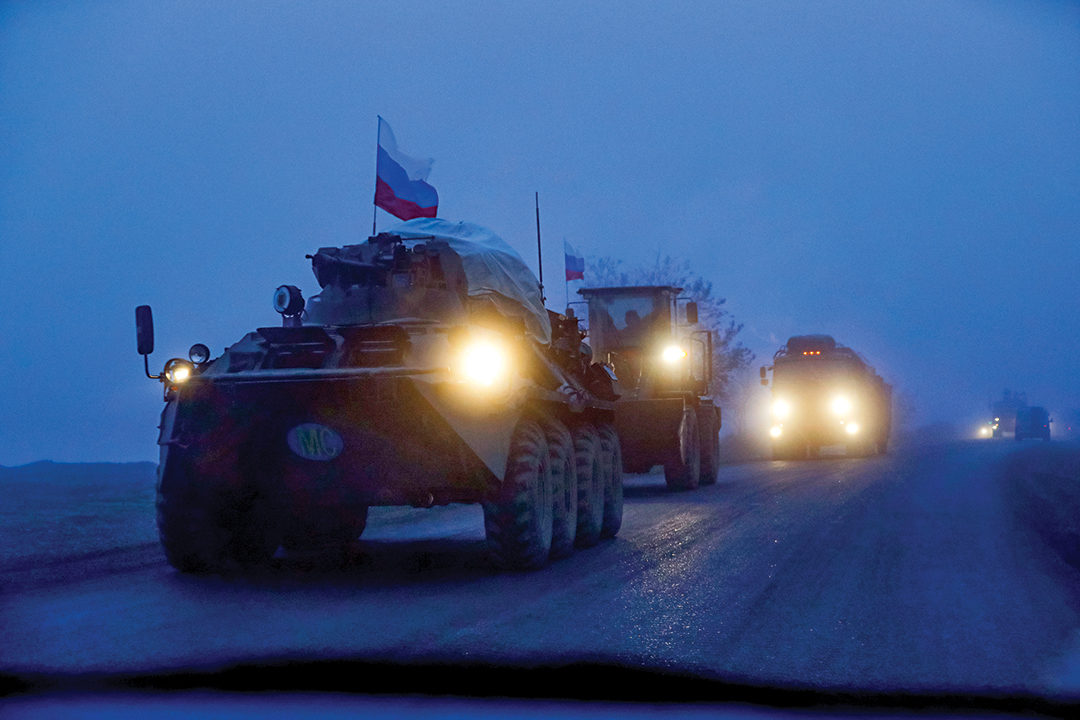
The Lachin corridor remains open to people, vehicles and goods in both directions, guaranteed by Azerbaijan and protected by Russian peacekeepers for five years. The new road construction linking Stepanakert to Lachin and bypassing Shusha presents a major physical challenge. Also, in accordance with the agreement, Armenia is to provide a transport link — the Meghri corridor — between the western regions of Azerbaijan and the Nakhchivan region, and this is guarded by Russian border guards. Armenia is a guarantor of security for the part of the Meghri corridor running through southeast Armenia, and Azerbaijan is a guarantor for the Lachin corridor, which implies that both states do not formally cede sovereignty. The cease-fire upheld uti possidetis claims, which may have ramifications for conflicts around Crimea and Donbas in Ukraine, South Ossetia and Abkhazia in Georgia, and Transnistria in Moldova.
Current assessment: “Winners” and “Losers”
As a result of the six-week war, approximately 70% of Nagorno-Karabakh proper remained in Armenian hands. This means that the uti possidetis principle, the basis of the dissolution of the Soviet Union, has not been restored and fully applied. In this sense, the conflict has not been fully resolved. In addition, the rearrangement of power relations between Armenia and Azerbaijan indicates that protracted conflicts can be moved out of stalemate through the use of force, a factor relevant to approaches to other protracted conflicts as well. Moreover, there is no political settlement between the two conflicting parties. Consequently, it is only a cease-fire that has been achieved. Several pending matters will remain for years to come while the hostilities are frozen between Armenia and Azerbaijan and a negative peace is imposed upon them.
Whether by default or design, the greater the number of disagreements between Azerbaijan and Armenia, the more indispensable Russian mediation and arbitration becomes. Russia may seek to manage reconciliation through a military deployment, in accordance with its “sufficiency of force” doctrine, but as in Syria and Libya, it does not control escalation dynamics in Nagorno-Karabakh. After five years, any signatory can ask to terminate the PKO. If such a request is not presented, the present status extends for another five years (and possibly longer). If the PKO is terminated, the risk that the conflict will resume increases, and this possibility acts as a deterrent against terminating the PKO.
It is clear that in the Kremlin’s calculus, the following factors did not weigh heavily: the financial costs of the PKO, the weakening of the credibility of CSTO security guarantees, the prospect of “losing Armenia” as a committed ally, and uncertainties over the undefined status of northern Nagorno-Karabakh and the Russian PKO itself. Russia bets that “a little bit of Turkey is better than a lot of the West,” particularly as Turkey appears overextended, with a weak economy. Moscow may be concerned, however, about the welfare of its own peacekeepers; about Turkish-Russian clashes, with Shusha-Stepanakert as a front-line flashpoint and potential source of escalation; and about the possibility of the complete collapse of Nagorno-Karabakh and with it the removal of a source of influence for Russia, as well as the damage to its reputation if its client were to experience complete failure.
On the rewards or benefits side of a nominal ledger are three clear wins for Russia. First, Russia’s response to the conflict represents an important step in reasserting Russian influence in the post-Soviet space. In essence, Russia demonstrates a more sophisticated approach to coercive mediation, with careful risk assessments of its operations and a more cautious assessment of what it needs to achieve. Second, a Western democratization dynamic in the South Caucasus has experienced a setback. The OSCE’s Minsk Group has accepted and legitimized Russia’s diplomatic initiative. Its co-chairs, France and the U.S., were sidelined, presented as they were with the binary logic: Legitimize the Russian PKO as a fait accompli, and with it the creation of a potential Russian protectorate, or accept a humanitarian catastrophe. Two authoritarian states (Azerbaijan and Turkey) militarily attacked a weak democracy (Armenia), which was saved from total defeat by a third authoritarian state (Russia). Third, Russia’s PKO demonstrates that the German mantra of “there can be no military solution” is false. Russia’s PKO was rapidly deployed, exerts control over multiple domains — humanitarian, political, military power and informational — and does not share control with civil society or other actors. It represents a top-down alternative, illiberal approach to peace, demonstrating that authoritarian models can be effective. If after five years the PKO is terminated, the risk that the conflict will resume may increase and this possibility acts as leverage over Armenia. Armenia and Nagorno-Karabakh are now fully dependent on Russian security guarantees, and Armenia is now even more firmly locked within the Russian orbit as a virtual supplicant and subordinate Russian garrison state.
Pashinyan, who had resisted calls for early elections immediately following the military defeat, held them in June 2021. In order not to fully lose Moscow’s support, Pashinyan made his “Walk to Canossa” to Putin in April 2021. The results of the parliamentary elections of June 20, 2021, weakened Pashinyan’s leadership but succeeded in avoiding the loss of power to an older generation of classically post-Soviet leaders — in this case, political forces led by former President Robert Kocharyan that are traditionally linked to the Nagorno-Karabakh conflict. Understandably the 54% of the vote for Pashinyan’s Civil Contract Party is far less than achieved in 2018, though still impressive following a lost war. This indicates that although Nagorno-Karabakh undoubtedly was an important issue in the election, it was not the only issue and was not decisive.
Azerbaijan was the clear victor of the conflict. Turkey has solidified ties with Azerbaijan. Aliyev and Erdoğan signed a Declaration on Alliance Relations between the two countries in the Karabakh town of Shusha on June 15, 2021. The Shusha Declaration formalizes the countries’ already existing agreements on mutual support and cooperation, references the Meghri corridor as the Zangazur corridor, and constitutes a “security umbrella,” according to a former Azeri foreign minister. Turkey projected power at low cost and appeared to effectively deter Russia from wholesale support for Armenia. Russia’s escalation of its efforts to manage the conflict places it in a riskier position than Turkey. Over the longer term, the peacekeeping operation risks irritating Azerbaijan and reminding Armenia of its humiliating dependence. Turkey now has additional levers of influence over Russia. Erdoğan’s recent call to normalize relations with the West, since the U.S. elections, increases the potential of Turkey aligning with Western policies in the region and highlights that U.S. recognition of the Armenian genocide has not had a discernable immediate impact on the region.
Turkey and Armenia, short of a full resolution of the Nagorno-Karabakh conflict, continue to have reasons not to establish political, diplomatic and economic relations. As a result, Armenia’s economic malaise will continue, and its heavy economic dependence upon Moscow cannot be overcome. Georgia, the third state of the South Caucasus, perceives the recent changes as a further deterioration of its security situation. It finds Russian military presence in its north, west and now more than ever in its south. This raises the issue of NATO’s further enlargement and the ongoing contest between Russia’s red-line policy and NATO’s declaration that adherence to democratic governance and reform is key to NATO membership, not the existence of forcibly annexed territory. ο


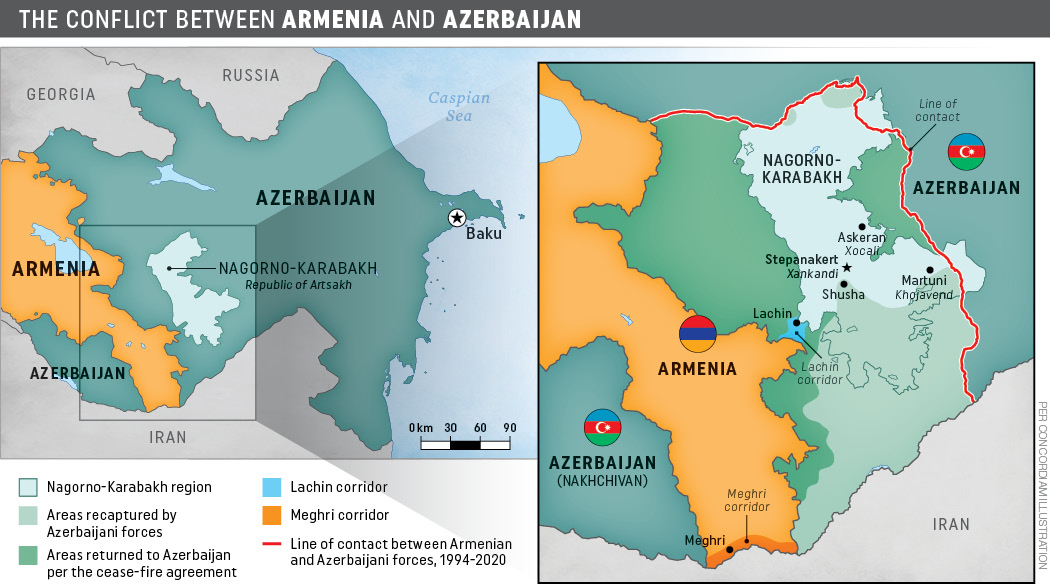
Comments are closed.